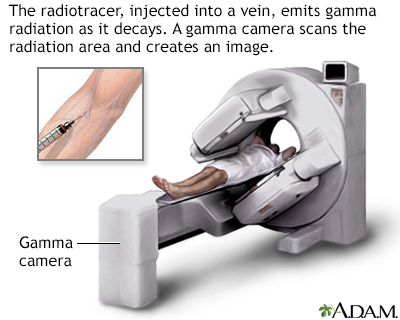Bone scan
Scintigraphy - bone
A bone scan is an imaging test used to diagnose bone diseases and find out how severe they are.
Images

I Would Like to Learn About:
How the Test is Performed
A bone scan involves injecting a very small amount of radioactive material (radiotracer) into a vein. This substance travels through your blood to your bones and organs. As it wears off, it gives off a bit of radiation. This radiation is detected by a camera that slowly scans your body. The camera takes pictures of how much radiotracer collects in your bones.
If a bone scan is done to see if you have a bone infection, images may be taken shortly after the radioactive material is injected and again 3 to 4 hours later, when it has collected in your bones. This process is called a 3-phase bone scan.
To evaluate whether cancer has spread to the bone (metastatic bone disease), images are taken only after the 3- to 4-hour delay.
The scanning part of the test will last about 1 hour. The scanner's camera may move above and around you. You may need to change positions.
You will probably be asked to drink extra water after you receive the radiotracer to help flush the material from your bladder.
How to Prepare for the Test
You must remove jewelry and other metal objects. You may be asked to wear a hospital gown.
Tell your health care provider if you are or may be pregnant.
Do not take any medicine with bismuth in it, such as Pepto-Bismol, for 4 days before the test.
Follow any other instructions you are given.
How the Test will Feel
There is a small amount of pain when the needle is inserted. During the scan, there is no pain. You must remain still during the scan. The technologist will tell you when to change positions.
You may experience some discomfort due to lying still for a long period.
Why the Test is Performed
A bone scan can be used to:
- Diagnose a bone tumor or cancer.
- Determine if a cancer that began elsewhere in your body has spread to your bones. Common cancers that spread to the bones include breast, lung, prostate, thyroid, and kidney.
- Diagnose a fracture, when it cannot be seen on a regular x-ray (most commonly hip fractures, stress fractures in the feet or legs, or spine fractures).
- Diagnose a bone infection (osteomyelitis).
- Diagnose or determine the cause of bone pain, when no other cause has been identified.
- Evaluate metabolic disorders, such as osteomalacia, primary hyperparathyroidism, osteoporosis, complex regional pain syndrome, and Paget disease.
Normal Results
Test results are considered normal if the radiotracer is present evenly throughout all the bones.
What Abnormal Results Mean
An abnormal scan will show hot spots or cold spots as compared to surrounding bone. Hot spots are areas where there is an increased collection of the radioactive material. Cold spots are areas that have taken up less of the radioactive material.
Bone scan findings must be compared with other imaging studies, such as x-rays or CT scans, in addition to clinical information. Your provider will discuss any abnormal findings with you.
Risks
If you are pregnant or nursing, the test may be postponed to prevent exposing your baby to radiation. If you must have the test while breastfeeding, you should pump and throw away the breast milk for the next 2 days.
The amount of radiation injected into your vein is very small. All radiation is gone from your body within 2 to 3 days. The radiotracer that is used exposes you to a very small amount of radiation. The risk is probably no greater than with routine x-rays.
Risks related to the bone radiotracer are rare, but may include:
- Anaphylaxis (severe allergic response)
- Rash
- Swelling
There is a slight risk of infection or bleeding when the needle is inserted into a vein.
Related Information
MetabolismBroken bone
Osteomyelitis
References
Kapoor G, Toms AP. Current status of imaging of the musculoskeletal system. In: Adam A, Dixon AK, Gillard JH, Schaefer-Prokop CM, eds. Grainger & Allison's Diagnostic Radiology. 7th ed. Philadelphia, PA: Elsevier; 2021:chap 38.
Ribbens C, Namur G. Bone scintigraphy and positron emission tomography. In: Hochberg MC, Gravallese EM, Smolen JS, van der Heijde D, Weinblatt ME, Weisman MH, eds. Rheumatology. 8th ed. Philadelphia, PA: Elsevier; 2023:chap 47.
BACK TO TOPReview Date: 5/19/2023
Reviewed By: Jatin M. Vyas, MD, PhD, Associate Professor in Medicine, Harvard Medical School; Associate in Medicine, Division of Infectious Disease, Department of Medicine, Massachusetts General Hospital, Boston, MA. Internal review and update on 01/31/2024 by David C. Dugdale, MD, Medical Director, Brenda Conaway, Editorial Director, and the A.D.A.M. Editorial team.

Health Content Provider
06/01/2025
|
A.D.A.M., Inc. is accredited by URAC, for Health Content Provider (www.urac.org). URAC's accreditation program is an independent audit to verify that A.D.A.M. follows rigorous standards of quality and accountability. A.D.A.M. is among the first to achieve this important distinction for online health information and services. Learn more about A.D.A.M.'s editorial policy, editorial process and privacy policy. A.D.A.M. is also a founding member of Hi-Ethics. This site complied with the HONcode standard for trustworthy health information from 1995 to 2022, after which HON (Health On the Net, a not-for-profit organization that promoted transparent and reliable health information online) was discontinued. |
The information provided herein should not be used during any medical emergency or for the diagnosis or treatment of any medical condition. A licensed medical professional should be consulted for diagnosis and treatment of any and all medical conditions. Links to other sites are provided for information only -- they do not constitute endorsements of those other sites. © 1997- 2025 A.D.A.M., a business unit of Ebix, Inc. Any duplication or distribution of the information contained herein is strictly prohibited.
